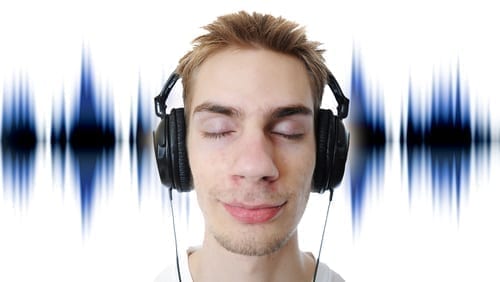
When I saw the verse in Exodus: “And all the people saw the sounds…” I asked myself how it was possible to see the sounds, and what did the People of Israel actually see at Mount Sinai? According to Rashi: “They saw the audible.” If so, it must be possible to convert sound waves into an image.
The first idea was to find the relationship between the audible frequencies (20 Hz-20 kHz) and the much higher, visible frequencies of color detected by the human eye, at wavelengths from 0.35 micron (violet) to 0.75 micron (red), which encompass all the colors of the spectrum.
According to one commentator, the Kli Yakar: “The People of Israel saw the letters.” In other words, God’s words were grasped as visible letters of the alphabet. Therefore, our conversion must retain the letters’ graphic forms, such as for example, the round shape of the fifteenth letter samech (ס). However, this assumes that the letters seen at Mount Sinai took the shape of the Ashuri script and not the ancient Hebrew script, in which the letter samech is written in an entirely different way.
However, the Talmud contains a difference of opinion as to which script was used (BT Sanhedrin 21b). One of the opinions claims that the Torah was given in the ancient Hebrew script, but after the return from the Babylonian exile, the change was made to the Ashuri script. The other opinion claims that the Torah was given in Ashuri script, and relates the word ashuri to the Hebrew word for honesty – yashrut.
That original script was lost over time and replaced by the ancient Hebrew script. With the return to the Land of Israel from Babylon, the original Ashuri script was rediscovered and used to write the scrolls of the Law. This script is in use to this day.
In addition, for the experiment to succeed, the shapes of the letters must appear as images when spoken. This means that they must appear from right to left, as in Hebrew. Thus, the graphic timeline must also flow from right to left as the letters appear on the computer monitor.
Through a microphone, sounds are expressed as changes in electrical current or voltage along a timeline. Further investigation revealed the complexity required for the frequency conversion; for converting sound to image requires an additional dimension. Whereas an image is two-dimensional, the sound develops along a timeline (time being the third dimension – ZC). Even if we say that the sound is also two-dimensional – a flow along the Y-axis relative to time along the X-axis, the image must still be three-dimensional:
Time on the X-axis, frequency on the Y-axis and force on the Z-axis.
However we look at it, we must add a dimension.
Doesn’t the fact that the Creator added a dimension to show us the sounds mean that it can be done?
In my CD lecture, I calculate the flow of information that must appear in real-time on the screen as a function of the flow of sound data. The relationship is more than 100/1 and therefore, when I began this research, it was impossible to facilitate the conversion on a computer because of the vast number of calculations involved. However, with the development of more powerful processing chips, it became possible to display the sounds continuously in real-time.
Finally, I reached the decision to display the image on the time-frequency plane, because I remembered the existence of a piece of electronic equipment called the sonograph, which I had seen years earlier at a university in Paris. This instrument displays a graphic representation of fluctuations in sound waves found in nature. It is interesting to see that it displays a bird’s chirping in the shape of a bird. This instrument put me in the right direction, despite the continued existence of a large number of unanswered questions, such as the difficulty in creating an image of the round letter samech, when the sonograph displays only lines.
Another important issue: Given that the Creator also formed the human ear, it is certain that He took human physiology into account when the sounds were seen at Mount Sinai. We therefore also had to take that into account and approach as close as possible the theoretical limits imposed by the Heisenberg Uncertainty Principle, which defines the relationship between the resolution in the time DT and the resolution in the frequency DF, according to the equation: DT ● DF >1/4 π. Meaning that it is impossible to be simultaneously accurate in both time and frequency.
To summarize, we can say that the new invention constitutes a new type of sonograph, with an algorithm that maintains the ear’s properties, while working at the limits of possible resolution. Therefore, it is sufficiently reliable to make it possible to see the letters of the Holy Tongue, as they are created by speech.
The Results
Out of the twenty-two letters in the Hebrew alphabet (the Ashuri script), I produced images for seventeen letters (or eighteen, if I count the sixth letter vav, which cannot be analyzed properly because it is a short vertical line). I must emphasize that the images were created directly from speech, through the use of a fixed mathematical conversion and the correct method of display.
To make it possible for anyone to do this experiment and see this amazing phenomenon for themselves, I have produced a CD with the appropriate software. All the seventeen findings are presented on the CD with explanations and the software that makes it possible to repeat the experiment.
I hope that with the correct pronunciation, it will be possible to add to the seventeen letters already displayable (which represent all five parts of the mouth used to produce the sounds): three gutturals, aleph, ayin and heh; three labials, peh, mem and bet; four palatals, gimmel, chaf, yod and kaf; two linguals, tet and nun; five dentals, zayin, samech, shin, tzadi and resh.
